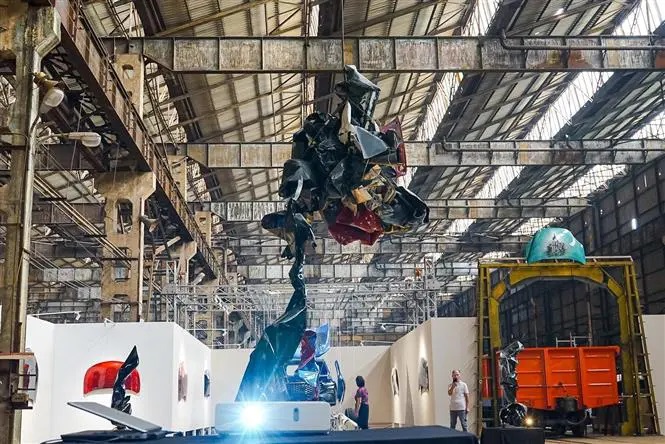Creativity contributes to promoting Vietnamese cultural soft power

Hanoi, January 13 (VNA) – Vietnam's cultural industries have helped bring the image of a beautiful nation with rich identity to the world. Many localities have successfully optimised the creativity factor in culture and turned culture into an attractive product with high socioeconomic values, thus building trademarks for many destinations.
Particularly, heritage that seemed to have been forgotten has now been "awakened" by the artistic creativity and enthusiasm of the community. It means that the community is joining hands to promote values and the "soft power" of the Vietnamese culture.
Awakening "sleeping" legacies
In 2019, Hanoi became the first Vietnamese city to join the UNESCO Creative Cities Network (UCCN) in the field of design, starting a period of international cooperation with an aim to turn culture and creativity into the foundation for sustainable development.
Since then, the capital city has affirmed the creativity of the more-than-a-thousand-year-old city. The highlight of the efforts is the Hanoi Creative Design Festival that was first held in 2021.
This year, the Hanoi Creative Design Festival is themed “Flow,” focusing on three key pillars of Design, Community and Creativity, aiming to awaken heritage with unique cultural values, turning industrial heritages into useful spaces with socioeconomic and cultural value.
The festival included more than 60 cultural activities, highlighting four architectural works, along with 20 exhibitions, 20 seminars and conferences, nine artistic activities, and creativity fairs. Particularly, the Gia Lam Station and Gia Lam Train Factory were turned into colourful creative art spaces attracting a large number of visitors.
According to Vice Chairwoman of the Hanoi People’s Committee Vu Thu Ha, the annual Hanoi Creative Design Festival has contributed to promoting the potential and advantages of the capital city. The event has also enhanced public awareness and expanded connectivity and cooperation between creative design and cultural industries, and implementing the city’s commitments when joining the UCCN.
Cultural experts asserted that the policy to move industrial production facilities out of the inner city has left a rich industrial heritage waiting to be awakened. The festival has brought about many experiences from turning industrial heritage into a complex of creative culture, services, and new products, contributing to implementing the city’s Cultural Industry Development Strategy, aiming for sustainable development.
Ramla Khalidi, UNDP Resident Representative in Vietnam said that the festival has not only honoured the diverse creative cultural resources of the capital, but has also revived cultural resources and brought new vitality to the city. Hanoi has proven that culture is a driving force for socioeconomic development by mobilising abundant youth energy for innovation, turning the capital into a place with better cultural experience for everyone.
Breakthrough orientations in knowledge-based economy development
In September 2016, the strategy for the development of Vietnam’s cultural industries until 2020 with a vision to 2030 was introduced, showing the country’s efforts in renovating the institutions and changing awareness to form policy frameworks for changes and integration of cultural industries.
Assoc. Prof. Dr. Nguyen Thi Thu Phuong, Director of the Vietnam Institute of Culture and Arts Studies (VICAS) held that the strategy’s implementation process has shown the capacity of protecting and promoting the diversity of cultural expressions, thus generally enhancing the image and attractiveness as well as the persuasiveness of Vietnam’s soft cultural strength.
According to the Ministry of Culture, Sports and Tourism, cultural industries, including cinematography, cultural tourism, performing arts, fine arts, photography, architecture, designing, publication, fashion, radio and television broadcasting, software, entertainment games, and handicrafts, have made considerable contributions to the economy.
The industries' production value was estimated at 1.059 quadrillion VND (44 billion USD) during 2018 - 2022. Contributions of cultural industries to the national GDP increased to 4.4% in 2022 from 3.92% in 2021. The contribution is expected to reach 7% in 2030, according to the strategy.
The strategy for developing cultural industries has promoted the formation of many programmes and initiatives. Particularly, Hanoi has become a member of the UCCN in the design category. Following Hanoi, this year, the ancient city of Hoi An in the central province of Quang Nam, and Da Lat city in the Central Highlands province of Lam Dong have been named in the UCCN in terms of music, and crafts and folk art, respectively. This will be an important basis for the country to build and perfect policies and measures to develop the cultural industries worthy of its inherent advantages and potential.
Addressing the first national teleconference on the development of the cultural industries in Vietnam on December 22, 2023, Prime Minister Pham Minh Chinh said that the growth of culture must contribute to building strong national identity, and must be placed in the overall situation of national socioeconomic development.
The PM emphasised that the development of the cultural industries must go along with the promotion and popularisation of the image of Vietnam and its people. Cultural products must meet the creative, professional, healthy, and sustainability requirements, thus building national trademarks for Vietnam’s cultural products and services to join national global chains./.





